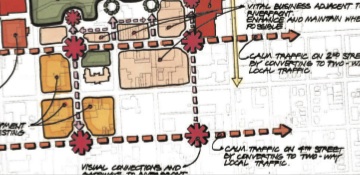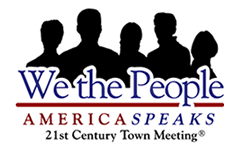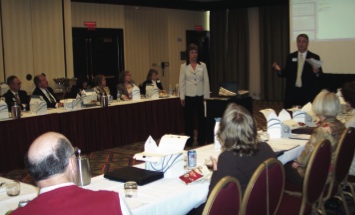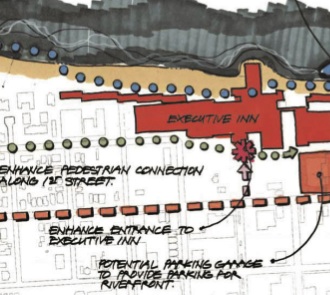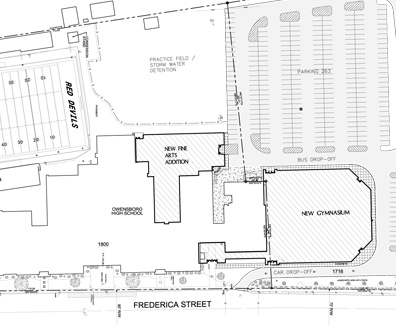- 401 Frederica Street, B-203
- Owensboro, Kentucky 42301
- (270) 685-2652 | FAX (270) 685-6074
Downtown/Community Development
The people have spoken. During the November 2007 AmericaSpeaks 21st Century Town Meeting®, the number one priority for community and economic development (and third highest recommendation overall) was to “transform downtown and insist on well-planned suburban expansion.”
The priority of downtown emerged from extensive deliberation involving more than 650 participants from all walks of life and all areas of Owensboro-Daviess County. Nearly 1,100 concerned citizens are now part of the “We the People” database.
The public yearns for a transformation of Owensboro-Daviess County, starting with the area that shapes our community image and sets the standard for county-wide and regional change. Citizens dream of a jewel along the Ohio River – a downtown that is a destination, a source of pride and a catalyst for economic development that will give us a competitive edge. People from all walks of life and all areas of Daviess County said that a vibrant downtown is key to tourism, arts and entertainment; key to a developing a distinctive, attractive, livable community.
Steps already underway. Since the town meeting, funds have been raised and one of the nation’s top consulting firms (Gateway Planning Group of Ft. Worth, Texas) has been retained to prepare a master plan for downtown that includes a design and implementation strategy. The consultants have introduced the latest urban design concepts that emphasize synergy between catalytic anchors, street vitality and livability within an urban village concept.
An unprecedented opportunity. From its initial assessment, the firm has stressed the critical importance and unique opportunity in assembling 18 or more acres on downtown’s west side, referring to the Executive Inn property as the “cornerstone of the downtown plan.” This is important because the hotel property adjoins a $45 million riverfront improvement plan.
On June 4, the Downtown Development Corporation (DDC) urged city and county governments to acquire or option the property and form a public-private partnership with one or more developers to ensure that the nascent master plan be followed.
However, the hotel closed on Monday, June 9, and by Thursday, June 19, an Evansville business woman and riverboat enthusiast, Mary Hukill, announced that she reached an agreement to buy the property. It was learned subsequently that she did not complete the transaction.
The DDC and other downtown proponents believe that the Executive Inn property needs to be owned or controlled by parties who will be amenable to working within the framework of the downtown master plan.
Our most ambitious project ever. Implementing the downtown master plan may prove to be the most challenging project ever for the Owensboro-Daviess County community, demanding leadership, private sector investment, high standards of design, and commitment of city and county government to work together and make this the top economic development priority.
The plan cannot be crafted and implemented quickly or hastily. Some projects will be built and succeed; other projects may go by the wayside. Leaders, community groups and citizens from all walks of life must embrace the vision and commit to a process of assiduous diligence to overcome the inevitable obstacles that will occur along the way.
Public participation essential. Shortly after the contract was signed with the downtown planning consultants, project coordinators outlined a process to ensure that there will be extensive opportunities for stakeholder and public participation in the nine-month planning period.
This spirit of participation and open dialogue was characterized by the June 12 “We the People” quarterly public meeting. Although early in the fact-finding stage, the consultants solicited impressions of the planning and design principles they are using and some of their preliminary ideas of the challenges and opportunities facing downtown Owensboro. Citizens asked questions, shared concerns, and reacted to preliminary concepts. The robust dialogue reflected the immense public interest in the project.
The planning and design process continued in early July as consultants met with stakeholder groups and complementary community organizations. These efforts will culminate in a community workshop in September and a public presentation to coincide with the first anniversary of the “We the People” AmericaSpeaks 21st Century Town Meeting®.
[Return to top]
|
Urban designers stress the importance and appeal of downtowns that are accommodating for pedestrians. While recognizing the importance of commerce, downtown Owensboro studies have consistently recommended that steps be taken to reduce if not eliminate the heavy traffic along Main Street (Second Street, U. S. Highway 60) to make downtown Owensboro more “people friendly.”
Currently, U.S. Highway 60 is one-way through the heart of our downtown, creating a visual barrier and deterrent from accessing the riverfront. Synchronized traffic lights result in higher speeds. Some truck access is necessary for shipping and receiving purposes, but the disruptive noise, spillage and exhaust is largely caused by thru-traffic: trucks with no business in the downtown area that use the shorter route through the city rather than the Wendell Ford Expressway (U.S. Highway 60 By-Pass).
The atmosphere is incompatible with retail and restaurant uses, particularly outdoor sidewalk dining and socializing. Main Street business owners say the current condition drives away business, is dirty and dangerous.
On signs at the city entrance east of Owensboro, truck drivers are advised to use the by-pass. This has not been an effective tool to reduce truck traffic.
The citizens of Owensboro-Daviess County – reflected in the outcomes from the “We the People” AmericaSpeaks 21st Century Town Meeting® – called for a transformation of downtown Owensboro. Citizens are asking: Can a downtown transformation occur and can the Riverfront Master Plan be fully actualized if Main Street is not appealing for people?
Elected officials, downtown boosters, concerned citizens and community leaders would be well-served to examine the following options:
Option 1: Leave the current traffic pattern alone
Commerce should be our top priority. Leave Second Street as it is. If more space is needed for pedestrians to gather, convert some parallel parking areas to landscaped plazas and sitting areas.
Option 2: Reroute traffic
Relocate a section of one-way Second Street to Third, Fourth or Fifth Street.
Option 3: Convert to a pedestrian-only area
Close traffic and create a pedestrian mall between the buildings along Second Street in the downtown.
Option 4: Convert to a limited access area
Allow emergency vehicles and mass transit (perhaps a trolley shuttle service) to have exclusive use of Second Street.
Option 5: Slow down the traffic
Redesign Second Street in a serpentine fashion or with two-way traffic and four-way stops. This would slow down traffic and allow angled parking.
These options warrant public dialogue within the framework of the downtown master plan. Traffic volume, pedestrian patterns, service to and potential disruption of commerce should be considered. Planners should be sensitive to historic preservation and potential development sites, parking, public gathering spots, construction and maintenance costs.
[Return to top]
Some proponents of the Gulfstream Enterprise Gateway Commons Highway 54 tax increment financing (TIF) proposal have tried to link the Executive Inn closing, Reid Haire's defeat in the Democratic Congressional primary, and a general lack of progress in our community to the failure of the 54 TIF.
They claim that the 54 TIF failed because a citizen group took legal action to challenge the TIF ordinance and because the Public Life Foundation ran a full page advertisement prior to the first public hearing on the TIF ordinance in order to raise questions about the proposal.
However, officials have pointed to at least five reasons why the U. S. Highway 54 TIF failed:
1. The proposal met none of the criteria in the state law.
2. There was intense public outcry that we would be turning our back on downtown redevelopment efforts and the $45 million riverfront improvement by building an arena, convention center, hotels and more on the U. S. Highway 54 site. Downtown redevelopment was identified as a top community priority in the "We the People" Town Meeting.
3. Concerns over the multi-million dollar development fees, legal fees, travel, marketing and other developer expenses to be absorbed by the taxpayers.
4. The relinquishing of public control over the scope, design and quality of a public arena and convention center to a private developer, and concerns over facility maintenance and operating subsidies. Moreover, the City's own arena feasibility study recommended a single multi-purpose events center that could accommodate sports activities; Gulfstream insisted on a separate arena and convention center.
5. The expectation that local governments should enter into a long-term, multi-million dollar agreement with a private firm that would not share its financial statements.
[Return to top]
In The World is Flat, author and journalist Thomas Friedman documented how technology has leveled the playing field to introduce unprecedented opportunity to bright, ambitious students and businesses across the globe. The linked world we live in enables someone in India to read our next x-ray and people in Beijing to be like next door neighbors. Outsourcing and global collaboration have created immense challenges and opportunities.
One way our community could send a message that we are embracing globalization is through the establishment of an International Center. Leading local employers already have international ties with corporate owners (Toyotetsu, Unilever, Swedish Match), foreign customers (Premium Allied Tool) and plants in other countries (MPD). Owensboro-Daviess County is increasingly racially and ethnically diverse.
An International Center could ease the transition to our community for people from other nations. Language courses, welcoming receptions, assistance with housing and paperwork are among the services that could be offered.
Programs such as the Friendship Force and Sister Cities could have a special presence in an International Center. Student exchange programs, church youth group summer mission trips, international relief efforts and other outreach efforts could be coordinated through the center.
Through an International Center, concerned citizens of Owensboro-Daviess County could adopt a village in Darfur or join other organizations as policy advocates.
Speakers, panel discussions and films on global issues presented by the Owensboro Area World Affairs Council (OAWAC) could be featured at the center and create special learning opportunities for high school and college students.
Sister Cities Director William West, Ph.D. has been pointing to the need and opportunity for an International Center for several years. Perhaps it is time we make it happen.
[Return to top]
Citizen Action/Perspectives
|
What has happened since the "We the People" 21st Century Town Meeting®? Has the event made a difference? Are more people involved in community action and the implementation of the town meeting recommendations?
More than a thousand people have been added to the database – concerned citizens who want to be kept informed and want great things for Owensboro-Daviess County. Some are choosing to be involved in new citizen groups established following the town meeting; others are taking their ideas to organizations in which they are already involved; others are getting involved individually as volunteers in service or advocacy.
A stronger administrative structure is in place to facilitate stability and sustainability. Shelly Nichols has been hired as executive director. A Leadership Council has been formed, chaired by Ed Allen, former superintendent of the Daviess County Public Schools.
Education
- The Community Education and Learning Committee (an outgrowth of the "We the People" 21st Century Town Meeting®) is developing a Citizen Participation Guide to facilitate parental and community involvement in our schools.
- The "Generations United" program will channel the valuable contribution of senior citizens into our schools and community.
- A public awareness campaign is planned to stress the importance of quality pre-school programs.
Community and Downtown Development
- The Region Of Opportunity Team (ROOT) (an outgrowth of the "We the People" 21st Century Town Meeting®) is involved in the comprehensive downtown master plan. A special effort is being made to ensure extensive participation by the public and stakeholder groups.
- Research is underway to identify cutting edge technical and economic development opportunities.
- Former Chamber of Commerce executive and educator Fred Reeves has been hired by city and county governments to coordinate downtown improvement initiatives.
Environmental Affairs
- The Environmental Impact Council (an outgrowth of the "We the People" 21st Century Town Meeting®) has invigorated efforts to establish curbside recycling in Owensboro-Daviess County.
- City and county governments are participating in the "Cool Cities" and "Cool Counties" programs for environmental conservation.
Health and Social Services
- The Healthy and Caring Community group (an outgrowth of the "We the People" 21st Century Town Meeting®) is partnering with Community Solutions for Substance Abuse to expand proven techniques to reduce substance abuse.
- Efforts are underway to support and expand the impact of the Owensboro Asset Building Coalition. Through the leadership of the Lawrence & Augusta Hager Education Foundation and the efforts of 80 volunteers, more than 2,000 low and moderate income families in Daviess County received free income tax preparation in 2008. This produced more than $2.2 million in income tax refunds and more than $900,000 in Earned Income Tax Credits.
- Plans are underway for a Volunteer Job Fair to connect citizens who want to make a difference with community organizations who need volunteers.
Government
- Citizens for Good Government (CGG) (an outgrowth of the "We the People" 21st Century Town Meeting®) is developing a set of principles on openness and transparency for the consideration of local elected and appointed public officials.
- CGG is also developing a series of programs to inform citizens of the structure, services and tax system of local governments, public agencies and tax districts.
For more information, contact:
Shelly Nichols, Executive Director
"We the People" Initiative
401 Frederica Street, B-203
270/685-2652
shelly.nichols@plfo.org
www.wethepeopletownmeeting.org
[Return to top]
|
Imagine an AmericaSpeaks 21st Century Town Meeting® occurring in six Kentucky cities – perhaps simultaneously, linked by technology. What if every area development district could host there own “We the People” town meeting? Or every county?
What if participants in these town meetings examined one or more pressing issues facing the Kentucky General Assembly? What if we reported on the recommendations and priorities of a large, informed and demographically representative group of citizens prior to the next session of the legislature? Would legislators listen?
The Public Life Foundation hosted a meeting in Louisville on May 13 to share our community’s experience with the AmericaSpeaks 21st Century Town Meeting® and to explore the interest in applying this or another form of public deliberation on a statewide basis.
Nearly 30 state leaders participated: policy analysts, journalists, those with experience in public deliberation, philanthropists, representatives of statewide networks, and a strong contingent of representatives of the Owensboro town meeting.
Some were familiar with the Owensboro town meeting. Others were introduced to our event. All were impressed with the participation, the substantive nature of the issues that were examined, and the subsequent implementation that is well underway.
There was a strong consensus to move forward and examine the advantages and disadvantages of various methodologies for statewide public deliberation and to examine which issues may be most appropriate for such an exercise. The group discussed the value of examining the gaming issue, or challenges facing education, the state prison population problem, taxation and spending issues, and more.
If you would like to be involved, contact the Public Life Foundation: 270/685-2652 or rodney.berry@plfo.org.
[Return to top]
|
For several years, an ad hoc task force of citizens has been examining the feasibility of a dental clinic for our community and region. Coordinated by Green River District Health Department’s JAT Mountjoy, the task force has studied models from other communities, made site visits, formed a nonprofit corporation and board of directors, prepared pro forma budgets, written grant proposals and more. Proponents intend to provide a resource for low-income families and students who need treatment following school screenings.
“We expect to serve approximately 1,000 patients annually,” said Mountjoy. “We will target Medicaid patients and those without dental insurance on a sliding scale basis.”
Many of the patients treated for dental pain at Owensboro Medical Health System (OMHS) will be referred to the clinic. Based on the current volume at OMHS and the savings achieved at a comparable clinic in Evansville, the dental clinic could save OMHS an estimated $270,000 per year.
Preliminary plans call for an office manager, dentist, dental assistant and a dental hygienist. The organization hopes to secure an office that can house two operatories and one for hygiene.
|
The board is raising funds through grants and contributions to acquire or lease space in a visible location, preferably near low-income neighborhoods and bus routes. This could cost as much as $500,000. The initial annual operating subsidy is expected to be $30,000-$40,000. The clinic hopes to be self-supporting in four or five years.
The clinic is intended to complement and not compete with other dental service providers. Complex procedures will be referred to specialists.
Local dentists who have offered encouragement, support and advice include: Mike Johnson, Terry Norris, Jay Crews, Robey Crowe, David Wilson and Kin Shaw.
Members of the clinic’s board of directors are: Rodney Berry, Public Life Foundation; Michael Johnson, DMD; JAT Mountjoy, Green River District Health Department; Beth Murphy, Foust Elementary School; Keith Sanders, Lawrence & Augusta Hager Education Foundation.
[Return to top]
The Foundation for a Healthy Kentucky recently released the results of the Kentucky Health Issues Poll. The random telephone survey of 1,632 adults was conducted January 16 - February 11, 2008 by the Institute for Policy Research at the University of Cincinnati.
Priorities from the survey include:
- Reducing the number of Kentucky youth without health insurance: 93 percent
- Reducing the cost of health care in Kentucky: 91 percent
- Improving Kentucky’s economy: 91 percent
- Improving job opportunities for Kentuckians: 90 percent
- Reducing the number of Kentucky adults without insurance: 87 percent
- Improving K-12 education: 87 percent
…compared with:
- Improving Kentucky roads and highways: 53 percent
- Placing casino gambling on the ballot in Kentucky: 22 percent
Additional information is available on the foundation’s website: www.healthyky.org.
[Return to top]
Government
The recent and unfortunate abrupt closing of the Executive Inn Rivermont in downtown Owensboro stirred debate over the proper role and action of city and county governments in property acquisition.
Evansville business woman, Mary Hukill, attempted to purchase the property but was unsuccessful.
Should city and county government acquire the land?
|
Those who believe they should not acquire the land have said…
- Government should stay out of the matter. The marketplace will adjust and correct itself. Businesses come and go; we have to accept that.
- A new owner will ultimately renovate the hotel or demolish it and build what the market can support.
- Local governments don’t have $8, $10, $12 million to spend on property.
- Government cannot dictate what a developer will build anyway.
Those who believe they should acquire the land have said…
- Government should take the lead when there is so much at stake: downtown development, convention-tourism industry, etc.
- Too much has been invested and is planned in riverfront improvements ($45 million), too great an opportunity to orchestrate a major redevelopment program on the 18 or more acres downtown along the riverfront.
- Local governments don’t need to come up with the purchase price. They need to service the debt for six months to a year while the downtown master plan is completed and then sell or lease various tracts to one or more developers.
- The City and County would have more leverage to bring about a development that is compatible with the master plan.
The issue is complex; there are other considerations. But the citizens of Owensboro-Daviess County would be well-served if leaders considered this issue of property acquisition carefully, thoroughly and objectively.
[Return to top]
|
Since the divisive 1990 referendum on city-county government merger, a volley of points pro and con continues to weave through community dialogue. Some are legitimate points; others are misguided or purposely misleading.
With no action from the Daviess County Fiscal Court, another effort to establish a commission to study (and potentially prepare) a charter for a unified city-county government has been set aside.
To foster public understanding on what can be a confusing issue to many, and to introduce the issue to a new generation of voters since 1990, it may be helpful to review exactly what was voted down in that referendum.
If merger had been approved…
GOVERNMENTAL ENTITIES & POWERS
- There would have been one government instead of three (Owensboro, Whitesville and Daviess County).
EXECUTIVE BRANCH
- The CEO would have been the County Judge/Executive, elected at-large in a partisan county-wide election for a four year term. The elected office of Mayor of Owensboro would have been eliminated.
- An appointed Chief Administrative Officer would have replaced the City Manager and the Deputy County Judge/Executive.
- There would have been single departments of Finance, Public Safety, Parks and Recreation, Sanitation and Public Works instead of two. Directors of departments would have been appointed by the CEO subject to the approval of the Council.
- The Daviess County Sheriff would have continued to collect taxes as set forth in state law.
- The Daviess County Jailer would have continued to operate the detention center as set forth in state law.
LEGISLATIVE BRANCH
- The legislative and policy-making body would have been a single Owensboro-Daviess County Urban County Government Council instead of the City Commission and the Daviess County Fiscal Court. The CEO would have been the chair and a voting member.
- Council members would have been elected as follows:
- Five in non-partisan district races (three inside the bypass and two outside the bypass)
- Three in partisan at-large districts (the same as the current county commission districts)
- Currently the four city commission races are at-large and non-partisan; the three county commission races are by districts and are partisan.
- Council members would have been required to live in their district and serve four-year terms.
- District boundaries would have been subject to redistricting by the Council to ensure population equity based on ten-year census information.
- Council members would have had no authority over local government employees (e.g., road crews)
- The votes of at least six Council members would have been required to restructure departments.
SERVICE DISTRICTS
- There would have been three service districts:
- General Services District
- The total Daviess County area, including Owensboro and Whitesville
- Services include: airport, animal control, building and electrical codes, civil defense, cultural services, community and economic development, drainage, police and fire department, health and social services, highways and streets, jail and detention, licensing, inspection, parks and recreation, planning and zoning, emergency dispatch, and general administration.
- Full Services District
- The area of the former City of Owensboro, including former "pockets" of county property within the city.
- Additional services include garbage and refuse collection and disposal, additional police and fire protection, public transit service, and street cleaning and lighting.
- Partial Services District
- The area outside the Full Services District to receive specified services of the Full Services District
- The Council would have had the option of extending the Full Services District by ordinance after a public hearing. The ordinance could be blocked by a vote of more than 50 percent of registered voters and landowners in the affected area.
TAXING DISTRICTS
- Taxes on real estate in each service district would have been based on the level of services provided.
- The initial tax rate on real estate would have been:
- In the General Services District, the same as the rate formerly imposed by Daviess County
- In the Full Services District, the same as the rate imposed by the City of Owensboro
- In "county pockets" within the Full Services District, reduced until full services are provided in such pockets.
PUBLIC SAFETY
- Fire protection would have been provided:
- In the Full Services District, through professional (fully-paid) services
- In the General Services District, through volunteer services
- Salaries, benefits, training and equipment for professional (fully-paid) and volunteer firefighters would have been funded by the urban-county government.
PUBLIC UTILITIES
- The new urban-county government would have assumed authority over Owensboro Municipal Utilities (OMU), although OMU's operations and territorial limits would not have been affected.
- OMU profits would have been allocated to the Full Services District budget.
- OMU payments in lieu of taxes would have been allocated to the General Services District budget.
- The Urban County Council would have designated sewer service districts with services based on fees and be directed to develop a comprehensive sewer services plan within a year.
TAXES & FEES
- The Council would have had the authority to impose an occupational tax and net license fee throughout the urban-county not to exceed one percent during its first fiscal year. (The current tax is 1.33 in the city and .5 in the county.)
- The Council would have had the authority to impose insurance license fees equal to 4.9 percent during its first fiscal year.
- The Council would have had the authority to impose motor vehicle license fees, miscellaneous business permits, fees and taxes comparable to the tax rate at that time.
- The Council would have been prohibited from imposing any fee, tax or other revenue measure during its first fiscal year that would have produced greater revenue than what was received at that time through the combined revenue sources of Owensboro, Whitesville and Daviess County.
BUDGET
- The urban-county government would have been obligated to operate within a balanced budget.
- The urban-county government would have established real property ad valorem tax rates (within the limits of state law) to fund operating and capital improvement budgets for each service district.
- The urban-county government would have the authority to levy other taxes permitted by state law provided such taxes are uniform through the urban-county as necessary to absorb operating and capital expenses not covered by real property ad valorem taxes.
BORROWING AND INDEBTEDNESS
- All existing Daviess County and Whitesville bonds would have been allocated to the General Services District.
- All existing City of Owensboro bonds would have been allocated to the Full Services District.
- All bonds issued to the urban-county government would have been allocated among districts according to the services rendered and within debt limits established by law.
GOVERNMENT EMPLOYEES
- Urban-county government employees would have been classified as civil service employees. (Exempt: elected officials, CEO, administrative assistants and certain secretaries appointed by the CEO.)
- Civil service regulations would have stayed in effect until the urban-county government adopted a civil service plan (within two years).
- City and County pension and retirement plans would have stayed in effect.
- All employees except police and fire employees would have been members of the County Employees Retirement System.
CONSTITUTIONAL OFFICES
- The CEO would have assumed the powers, duties and term of office of the Daviess County Judge/Executive.
- The CEO and the three at-large Council members would constitute the Fiscal Court and oversee water districts and rural road program without power to levy taxes or administer governmental affairs.
- Each at-large Council member would have served as Justice of the Peace for the district from which elected.
- The Sheriff would remain a peace officer, but Chief of Police would have served as the principal peace officer.
- The plan would not have affected powers, duties or terms of office of the county court clerk, circuit court clerk, commonwealth attorney, constable, jailer, coroner, county attorney, property valuation administer, or justice of the peace.
It is unclear what specifically was so controversial in the merger proposal. There has not been an assessment of public support or opposition to specific components of the proposal.
Analysts conclude that opposition was rooted more in the sense that: 1. Public services (and tax increases to pay for them) would be arbitrarily extended; 2. Representation and relationships with elected officials would be diluted under a merged system; 3. Merger would mean bigger government.
In some circles, there was also a sense that merger would impose "urban" amenities (e.g., arts, library, etc.) disproportionately onto rural residents, and that "rural" lifestyles and activities (e.g., hunting) would have restrictions. Many of these points are still subject to interpretation, but there is no evidence that the charter proposal itself would result in these speculated outcomes.
[Return to top]
|
In our last edition, we published an issue brief on the exploding prison population problem. The brief will be used as a discussion guide during an upcoming public forum. Information on the forum (date, time and location) will be forthcoming.
We plan to use the keypad technology that was used during the "We the People" 21st Century Town Meeting. Contact us if you are interested in participating as a table facilitator or recorder, 685-2652 or kathy.strobel@plfo.org
[Return to top]
Quality of Life/Livability
The vision and initiative of RiverPark Center CEO Zev Buffman has led to the International Mystery Writer’s Festival, Young Adult Theater Academy, Broadway show production combined with the launching of international tours, Winter Wonderland and more. Each of these events requires sponsors and grants. RiverPark Center also faces major maintenance, debt retirement and its endowment is inadequate.
International Bluegrass Music Museum (IBMM) Executive Director Gabrielle Gray continues to attract valuable artifacts while juggling an impressive array of projects. IBMM is tapping a global market of bluegrass music listeners through Radio Bluegrass International. It has launched a 24-hour Internet radio program, a Video Oral History project, River of Music Party (ROMP), Bluegrass in the Schools program, music camps, a Saturday bluegrass instrument lessons program and more. Yet about half of the museum’s $680,000 annual budget must be raised through sponsorships, memberships, grants and contributions.
The Owensboro Symphony Orchestra, Owensboro Museum of Fine Art, Owensboro Area Museum of Science and History, Theatre Workshop, Owensboro Dance Theater, Owensboro Choral Society, Yellowbanks Dulcimer Festival, Owensboro Art Guild, Public Art Commission and more reflect a community that values the arts.
However, most of these organizations struggle financially and face disturbing challenges to sustain facilities, underwrite programs and retain experienced staff.
Perhaps it is time that Owensboro-Daviess County examine the feasibility of a community-wide (perhaps region-wide) fund for the arts.
Such a fund could combine annual membership appeals while leaving capital and endowment campaigns, special event fundraising, program and exhibit sponsorships, and grantwriting to the individual organizations.
Many potential donors who may feel overwhelmed by multiple annual appeals may be willing to support the overall arts community. Rather than dilute the existing membership base, a united arts fund could expand the donor base because many employers may agree to assist with payroll deduction plans. The administration of separate payroll deduction plans for individual arts organizations could be burdensome. United arts campaigns typically do not reduce other charitable giving.
The Louisville Fund for the Arts attracted $9 million in 2008 and supports 25 organizations. If Owensboro-Daviess County generated 10 percent of that total, we would more than double the amount that is currently raised by local arts organizations through memberships and general contributions. This would not only shore up existing organizations, but provide seed money for new initiatives, special programs and more.
[Return to top]
|
Several recently completed or planned buildings, funded with tax dollars, will have a major impact on our community’s visual landscape: Daviess County Public Library; Western Kentucky University-Owensboro; Owensboro High School gymnasium and fine arts expansion; Legion Park picnic shelter.
PRIDE, a citizens group that promotes public participation in community design and aesthetic issues, encourages high standards of design for our public buildings and substantive public participation throughout the design process.
While preferences for various architectural designs and features can be subjective, it is important to gauge public reaction to basic building prototypes and key features since, after all, the public is footing the bill.
Design decisions are often made by a few leaders and the architects. Mandated public hearings typically present a building design for public comment after the design is essentially complete rather than present options for a building design early in the process in order to foster meaningful public dialogue.
PRIDE is a resource that can facilitate public participation in architectural decisions that shape the image of our community. On July 17 (5:30 p.m., English Park Shelter) PRIDE will host a meeting in which the design of several major community projects will be discussed. This is encouraging and a credit to PRIDE.
All major public buildings should involve a design review committee with broad citizen membership. If necessary, such a committee can seek the input of outside resources, such as the University of Kentucky College of Design and the American Association of Architects.
[Return to top]
News & Notes
Jennifer Wright, project manager for the “We the People” AmericaSpeaks 21st Century Town Meeting® in Owensboro in November 2007, recently joined the Associates Network for the Washington DC-based organization.
Jennifer and her family are finalizing plans to relocate to Savannah, Georgia this summer where her husband recently accepted a position. As an associate with AmericaSpeaks, Jennifer will join others with skills in project management, government relations, public policy, organizational development, meeting design and organizing.
AmericaSpeaks Associates are located across the country and offer their time and talents as needed in town meetings across the U.S. and other nations.Prior to the Owensboro event, Jennifer assisted with an ambitious six-city town meeting that focused on California health care reform proposals. The meetings, involving 300 to 1,000 participants, were held simultaneously and linked by technology.


